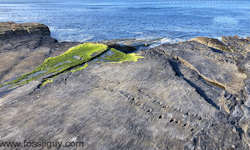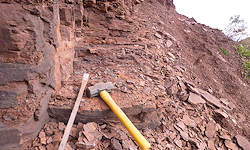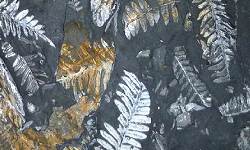Paleontology News

A life reconstruction of Anteosaurus attacking a herbivorous Moschognathus. Image credit: Alex Bernardini (@SimplexPaleo)
Anteosaurus turns out to be a prehistoric killing machine
Summary Points

Figure 2 from Benoit et al. 2021 showing an occiput fragment of Anteosaurus magnificus with the braincase enlarged. (CC by 4.0)
Anteosaurus was a type of dinocephalian, which is a pre-mammal like animal that ruled the Permian of Africa 30 million years before the first Dinosaurs.
They were large (up to 20 feet) carnivorous predators with large skulls containing muscular jaws lined with giant bone crushing teeth.
Once thought to be slow and sluggish, a new study shows these animals may have been active and agile predators.
The new study revealed the internal structure of the skulls, showing features found in agile predators.
Anteosaurus: Once thought to be slow and sluggish, this giant Permian animal is now thought to be an agile predator!
This article is based on a Press Release by Wits University - March 3, 2021, and the related Journal Article (Benoit et al, 2021).
Anteosaurus was a type of dinocephalian, which is a pre-mammal like animal that ruled the Permian of Africa 30 million years before the first Dinosaurs.
Growing up to 20 feet in length, they were among the largest animals of the Permian. Think of them as large carnivorous Rhinoceroses with tails and large skulls containing muscular jaws lined with giant bone crushing teeth!
Fossils of these giant animals from the Permian are very fragmentary, and paleontologists thought the bones were too heavy and the animal would be too sluggish to be an active hunter. Instead they though it may have scavenged, or at most, ambushed its prey. "Some scientists even suggested that Anteosaurus was so heavy that it could only have lived in water," says Dr Julien Benoit of the Evolutionary Studies Institute at the University of the Witwatersrand (Wits University).
However, a new study by Julien Benoit and a team of paleontologists took a careful look at the skull and digitally reconstructed it using X-ray imaging and 3D reconstructions. They were able to investigate the internal structures of the skull and compare them to active hunters.
What they found was anything but a slow and sluggish animal. Instead, they found a larger balance organ in its inner ear and an exceptionally large part of the brain responsible for coordinating the movements of the eyes. These traits are found in agile predators.
"In creating the most complete reconstruction of an Anteosaurus skull to date, we found that overall, the nervous system of Anteosaurus was optimized and specialized for hunting swiftly and striking fast, unlike what was previously believed," says Dr Ashley Kruger from the Natural History Museum in Stockholm, Sweden.
Dr Julien Benoit says "Even though Anteosaurus lived 200-million years before the famous dinosaur Tyrannosaurus rex, Anteosaurus was definitely not a 'primitive' creature, and was nothing short of a mighty prehistoric killing machine."

Figure 3 from Benoit et al. 2021 of 3D models of two Anteosaurus magnificus skulls revealing the internal structure. (CC by 4.0)

The skull of Anteosaurus compared to a modern human. Image credit: Wits University

Anteosaurus in the Permian landscape. Reconstruction by Bogdanov (CC BY-SA 3.0)
Journal Article:
Julien Benoit, Ashley Kruger, Sifelani Jirah, Vincent Fernandez, Bruce Rubidge. (2021) Palaeoneurology and palaeobiology of the dinocephalian Anteosaurus magnificus. Acta Palaeontologica Polonica, 2021; 66 DOI: 10.4202/app.00800.2020
Recommended Permian Books:
Earth before the Dinosaurs
by Sebastien Steyer (Author), Alain Beneteau (Illustrator), Chris Spence (Translator) (2012)
This beautifully illustrated paperback provides a window into the strange creatures that existed before the Dinosaurs.
Many people have a gap in knowledge about life on Earth before the Mesozoic. There was a vast array of
bizarre reptilian and mammal-like animals that ruled the Earth for 100's of millions of years before the Dinosaurs!
When Life Nearly Died: The Greatest Mass Extinction of All Time (2nd Ed)
Michael J. Benton, (2015)
This book focuses on the greatest mass extinction to grip the Earth, the end-Permian extinction 250 million years ago. Life was completely
different before the Dinosaurs during the Permian. What caused this mass extinction? What evidence do we have? How did this extinction change the course of evolution? Available in Kindle, Audio, or Actual Book
Browse More Paleontology News
Related Content
About the Author
Contact Us
To ask Questions about Paleontology, Fossil Identification, Image Use, or anything else, email us.
Fossilguy.com is very active on Facebook, you can also message us there!
We don't buy or sell fossils, so please don't email us asking about the value of a fossil or fossil purchases.
Visit us on Social Media:
Enjoy this website?
Consider a Paypal / Credit Card donation of any size to help with site maintenance and web hosting fees:
Privacy Policy and Legal Disclaimer
Back to the TOP of page
© 2000 - 2025 : All rights reserved
Fossilguy.com is a participant in the Amazon Services LLC Associates Program, an affiliate advertising program designed to provide a means for sites to earn advertising
fees by advertising and linking to amazon.com









